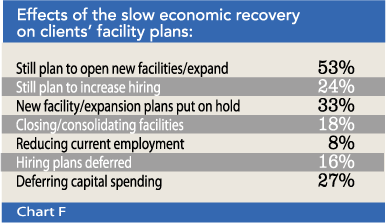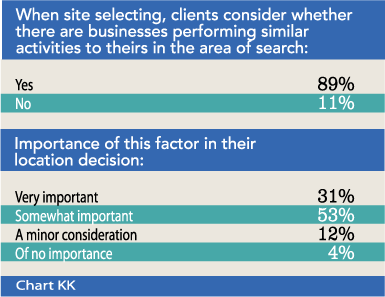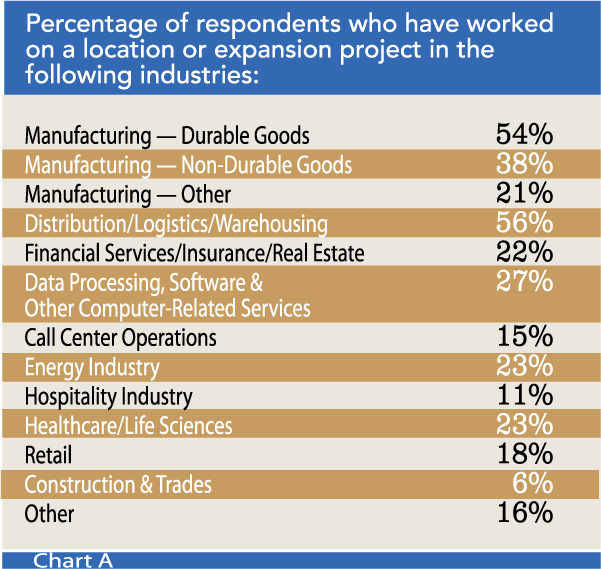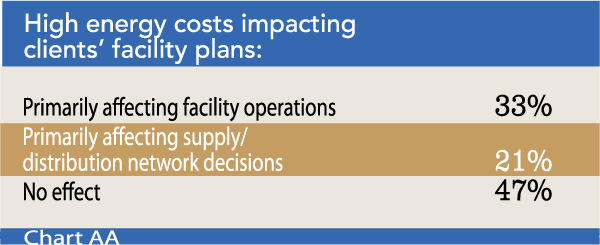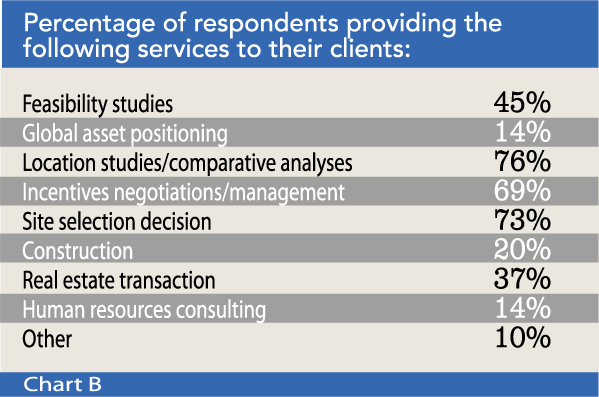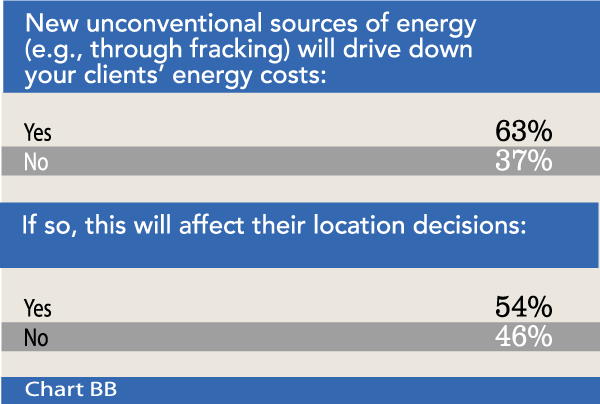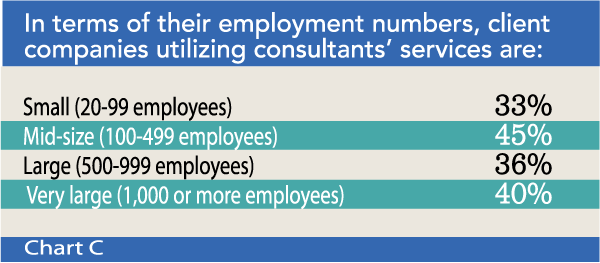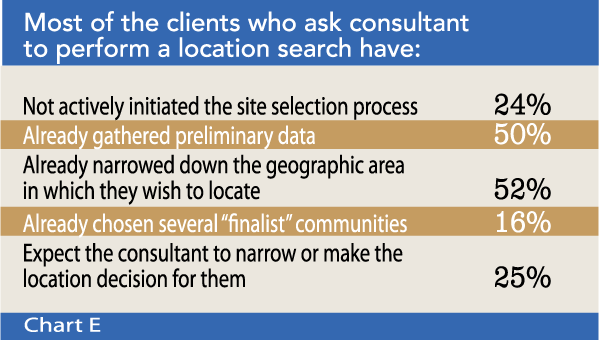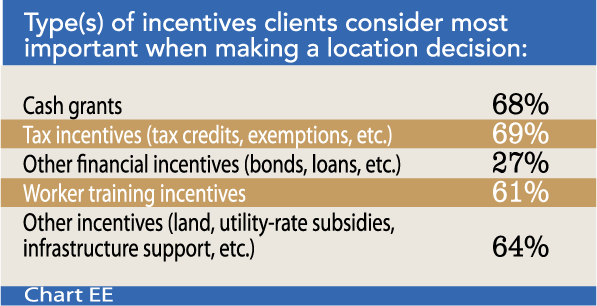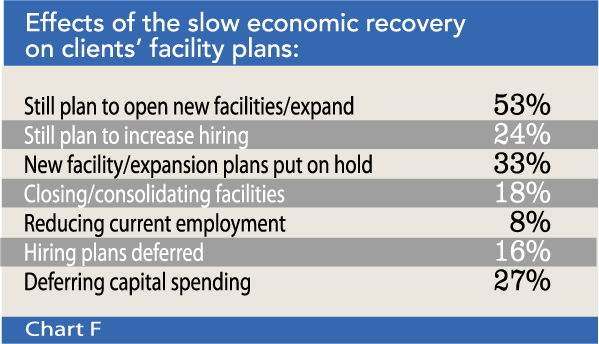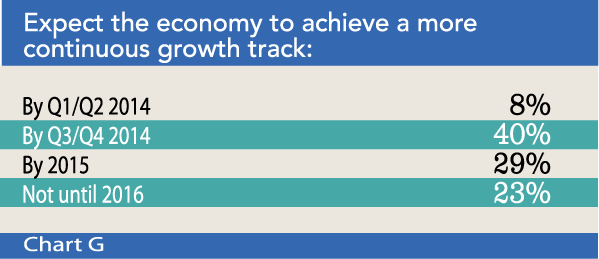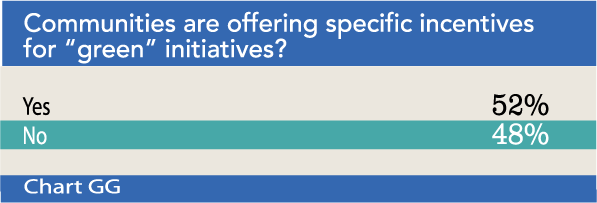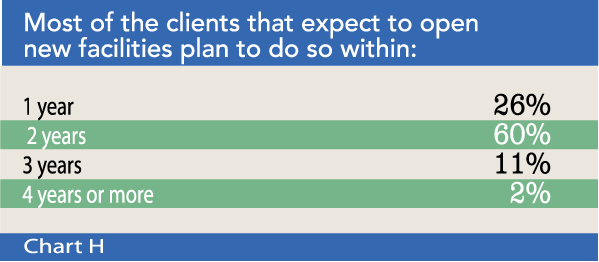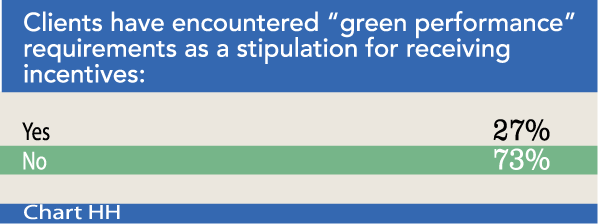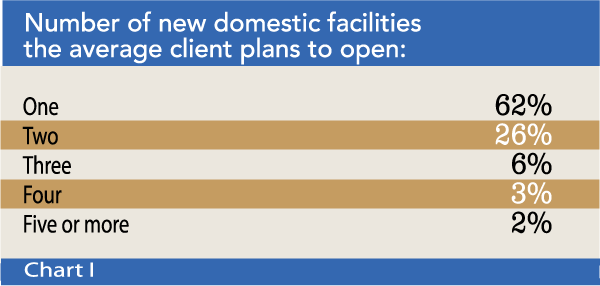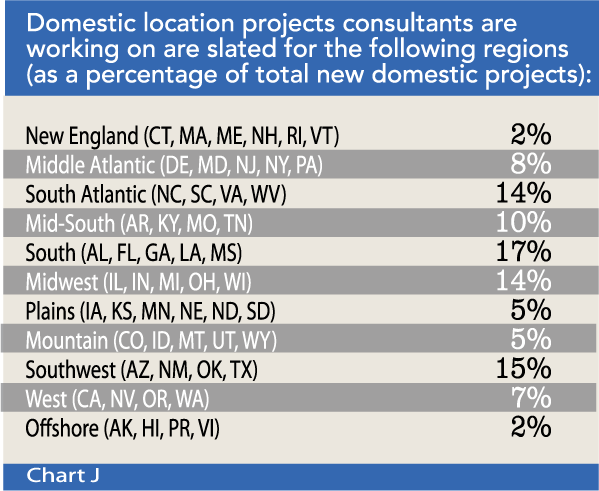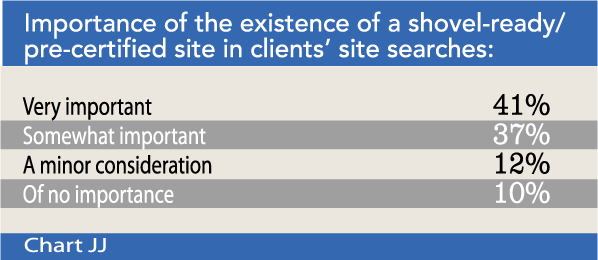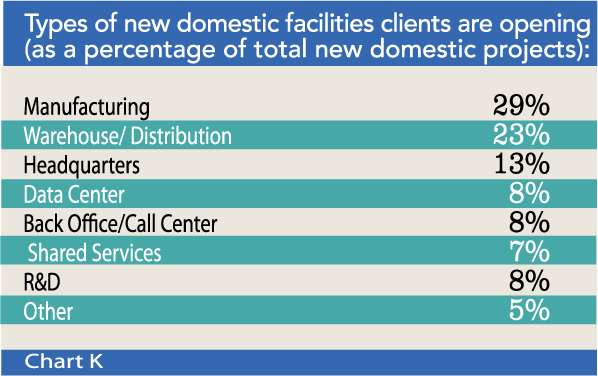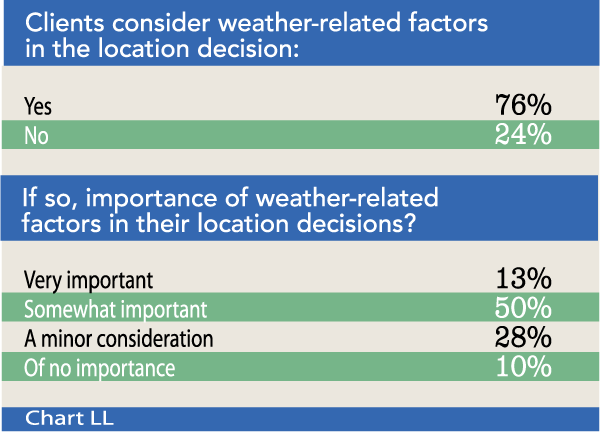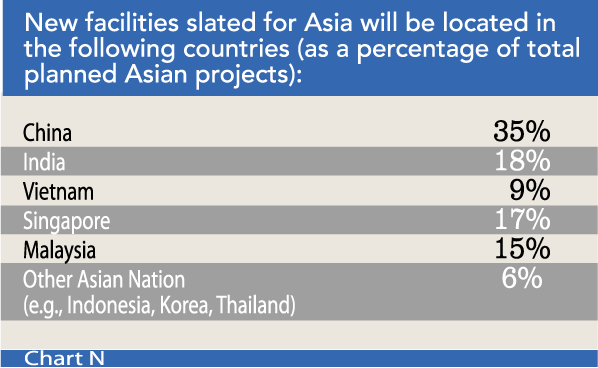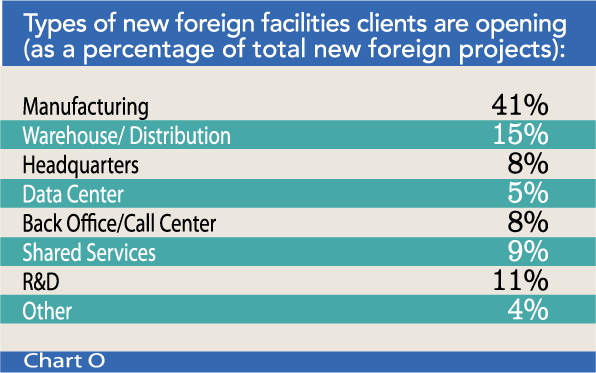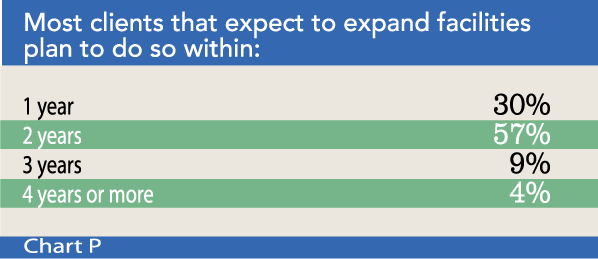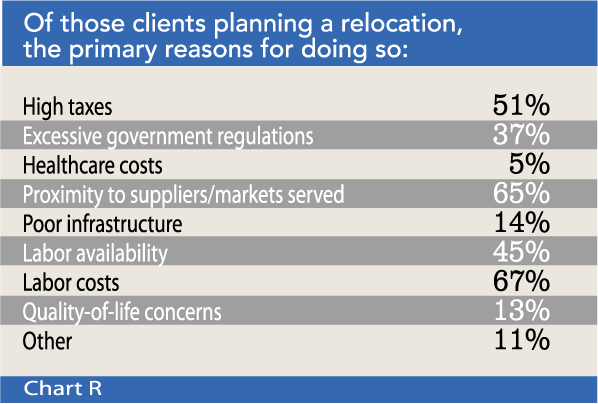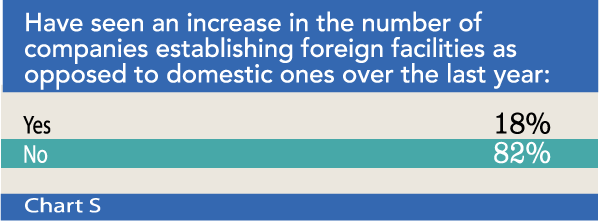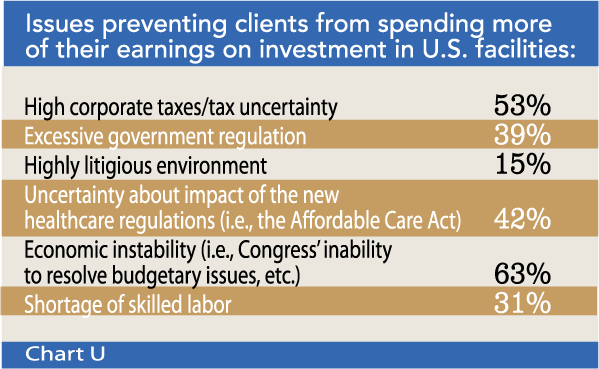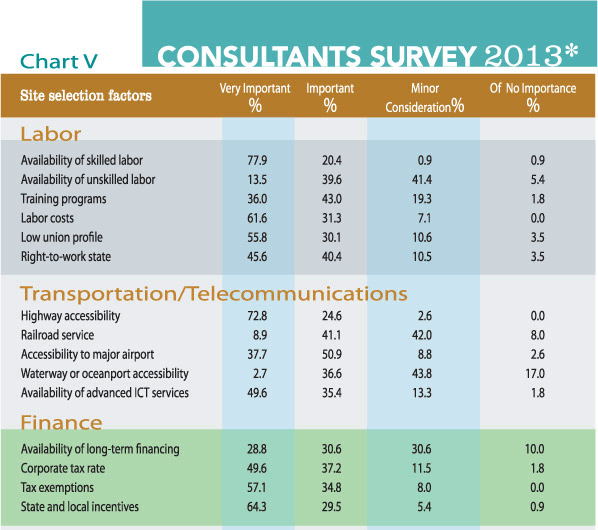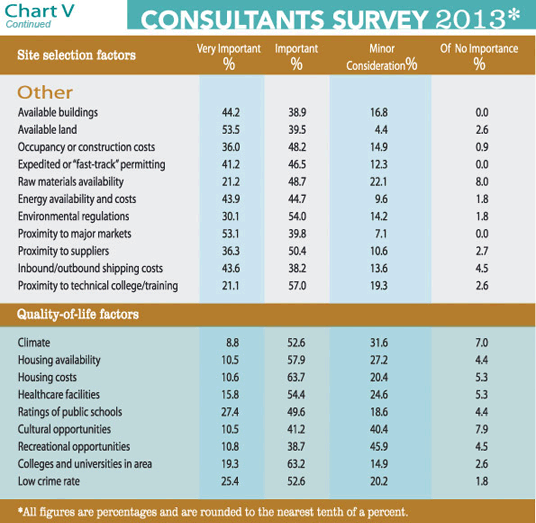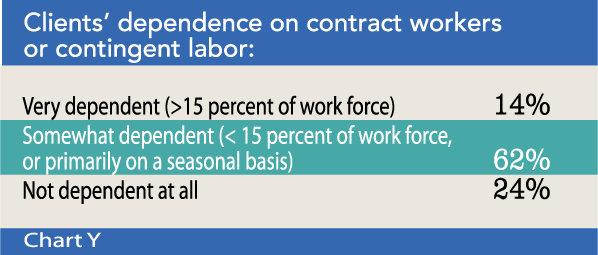As in years past, Area Development asked the consultants who work with corporate clients to tell us about their clients’ facilities plans and priorities in making a location decision. Fewer than half (43 percent) of those responding to our 2013 Corporate Survey say they use the services of consultants so let’s find out which companies the consultants are serving and how the Consultants Survey responses align with the Corporate Survey responses.
{{RELATEDLINKS}}
The Consultants Survey Respondents
Slightly more than half of those responding to our 10th annual Consultants Survey say they work with durable goods manufacturers as well as distribution/logistics/warehousing firms. Nearly 40 percent also claim to work with nondurable goods manufacturers, and more than 20 percent have also been engaged in location and expansion projects for the financial services/insurance/real estate; data processing, software, and computer-related services; and life sciences and energy industries (Chart A).
About three quarters of the responding consultants say they provide their clients with location studies/comparative analyses as well as help with the site selection decision. Their other primary role is incentives negotiation and management, as per 69 percent of the respondents (Chart B).
The responding consultants’ clients are of varying sizes in terms of employment numbers. About a third say they work with companies having fewer than 100 employees, but 40 percent also say they work with firms that employ 1,000 or more people (Chart C).
Slideshow10th Annual Survey of Site Selection Consultants Results

Close
 Chart A: Percentage of respondents who have worked on a location or expansion project in the following industries
Chart A: Percentage of respondents who have worked on a location or expansion project in the following industries
 Chart AA: High energy costs impacting clients’ facility plans
Chart AA: High energy costs impacting clients’ facility plans
 Chart B: Percentage of respondents providing the following services to their clients
Chart B: Percentage of respondents providing the following services to their clients
 Chart BB: New unconventional sources of energy (e.g., through fracking) will drive down your clients’ energy costs
Chart BB: New unconventional sources of energy (e.g., through fracking) will drive down your clients’ energy costs
 Chart C: In terms of their employment numbers, client companies utilizing consultants' services are
Chart C: In terms of their employment numbers, client companies utilizing consultants' services are
 Chart CC: Sustainable development is more important to clients now than in the past
Chart CC: Sustainable development is more important to clients now than in the past
 Chart D: Departments of clients’ organizations significantly involved in the site selection process/project
Chart D: Departments of clients’ organizations significantly involved in the site selection process/project
 Chart DD: Relative importance of incentives to clients when making location decisions
Chart DD: Relative importance of incentives to clients when making location decisions
 Chart E: Most of the clients who ask consultant to perform a location search have
Chart E: Most of the clients who ask consultant to perform a location search have
 Chart EE: Type(s) of incentives clients consider most important when making a location decision
Chart EE: Type(s) of incentives clients consider most important when making a location decision
 Chart F: Effects of the slow economic recovery on clients’ facility plans
Chart F: Effects of the slow economic recovery on clients’ facility plans
 Chart FF: Clients have had to repay incentives monies because investment and/or job creation obligations were not met
Chart FF: Clients have had to repay incentives monies because investment and/or job creation obligations were not met
 Chart G: Expect the economy to achieve a more continuous growth track
Chart G: Expect the economy to achieve a more continuous growth track
 Chart GG: Communities are offering specific incentives for “green” initiatives?
Chart GG: Communities are offering specific incentives for “green” initiatives?
 Chart H: Most of the clients that expect to open new facilities plan to do so within
Chart H: Most of the clients that expect to open new facilities plan to do so within
 Chart HH: Clients have encountered “green performance” requirements as a stipulation for receiving incentives
Chart HH: Clients have encountered “green performance” requirements as a stipulation for receiving incentives
 Chart I: Number of new domestic facilities the average client plans to open
Chart I: Number of new domestic facilities the average client plans to open
 Chart II: Importance of the existence of an available building in clients’ site searches
Chart II: Importance of the existence of an available building in clients’ site searches
 Chart J:Domestic location projects consultants are working on are slated for the following regions (as a percentage of total new domestic projects)
Chart J:Domestic location projects consultants are working on are slated for the following regions (as a percentage of total new domestic projects)
 Chart JJ: Importance of the existence of a shovel-ready/pre-certified site in clients’ site searches:
Chart JJ: Importance of the existence of a shovel-ready/pre-certified site in clients’ site searches:
 Chart K: Types of new domestic facilities clients are opening (as a percentage of total new domestic projects)
Chart K: Types of new domestic facilities clients are opening (as a percentage of total new domestic projects)
 Chart KK: When site selecting, clients consider whether there are businesses performing similar activities to theirs in the area of search
Chart KK: When site selecting, clients consider whether there are businesses performing similar activities to theirs in the area of search
 Chart L: Number of new foreign facilities the average client plans to open
Chart L: Number of new foreign facilities the average client plans to open
 Chart LL: Clients consider weather-related factors in the location decision
Chart LL: Clients consider weather-related factors in the location decision
 Chart M: Foreign location projects consultants are working on are slated for the following regions (as a percentage of total new foreign projects)
Chart M: Foreign location projects consultants are working on are slated for the following regions (as a percentage of total new foreign projects)
 Chart N: New facilities slated for Asia will be located in the following countries (as a percentage of total planned Asian projects)
Chart N: New facilities slated for Asia will be located in the following countries (as a percentage of total planned Asian projects)
 Chart O: Types of new foreign facilities clients are opening (as a percentage of total new foreign projects)
Chart O: Types of new foreign facilities clients are opening (as a percentage of total new foreign projects)
 Chart P: Most clients that expect to expand facilities plan to do so within
Chart P: Most clients that expect to expand facilities plan to do so within
 Chart Q: Most clients that expect to expand facilities plan to do so within
Chart Q: Most clients that expect to expand facilities plan to do so within
 Chart R: Of those clients planning a relocation, the primary reasons for doing so
Chart R: Of those clients planning a relocation, the primary reasons for doing so
 Chart S: Have seen an increase in the number of companies establishing foreign facilities as opposed to domestic ones over the last year
Chart S: Have seen an increase in the number of companies establishing foreign facilities as opposed to domestic ones over the last year
 Chart T: Clients have relocated a facility back to the U.S. from a foreign location
Chart T: Clients have relocated a facility back to the U.S. from a foreign location
 Chart U: Issues preventing clients from spending more of their earnings on investment in U.S. facilities
Chart U: Issues preventing clients from spending more of their earnings on investment in U.S. facilities
 Chart V: We also asked those taking our Consultants Survey to rate the site selection and quality-of-life factors that come into play in their clients’ location and expansion decisions as either “very important,” “important,” “minor consideration,” or “of no importance.” These ratings are shown in Chart V.
Chart V: We also asked those taking our Consultants Survey to rate the site selection and quality-of-life factors that come into play in their clients’ location and expansion decisions as either “very important,” “important,” “minor consideration,” or “of no importance.” These ratings are shown in Chart V.
 Chart V (continued): We also asked those taking our Consultants Survey to rate the site selection and quality-of-life factors that come into play in their clients’ location and expansion decisions as either “very important,” “important,” “minor consideration,” or “of no importance.” These ratings are shown in Chart V.
Chart V (continued): We also asked those taking our Consultants Survey to rate the site selection and quality-of-life factors that come into play in their clients’ location and expansion decisions as either “very important,” “important,” “minor consideration,” or “of no importance.” These ratings are shown in Chart V.
 We also asked those taking our Consultants Survey to rate the site selection and quality-of-life factors that come into play in their clients’ location and expansion decisions as either “very important,” “important,” “minor consideration,” or “of no importance.” These ratings are shown in Chart V. We then added the “very important” and “important” ratings in order to rank the factors in order of overall importance, as shown in Chart W.
We also asked those taking our Consultants Survey to rate the site selection and quality-of-life factors that come into play in their clients’ location and expansion decisions as either “very important,” “important,” “minor consideration,” or “of no importance.” These ratings are shown in Chart V. We then added the “very important” and “important” ratings in order to rank the factors in order of overall importance, as shown in Chart W.
 Chart W (continued): We also asked those taking our Consultants Survey to rate the site selection and quality-of-life factors that come into play in their clients’ location and expansion decisions as either “very important,” “important,” “minor consideration,” or “of no importance.” These ratings are shown in Chart V. We then added the “very important” and “important” ratings in order to rank the factors in order of overall importance, as shown in Chart W.
Chart W (continued): We also asked those taking our Consultants Survey to rate the site selection and quality-of-life factors that come into play in their clients’ location and expansion decisions as either “very important,” “important,” “minor consideration,” or “of no importance.” These ratings are shown in Chart V. We then added the “very important” and “important” ratings in order to rank the factors in order of overall importance, as shown in Chart W.
 Chart X: Higher unemployment rates making it easier for clients to find the labor they need
Chart X: Higher unemployment rates making it easier for clients to find the labor they need
 Chart Y: Clients’ dependence on contract workers or contingent labor
Chart Y: Clients’ dependence on contract workers or contingent labor
 Chart Z: Percentage of contract labor clients employ at any given time
Chart Z: Percentage of contract labor clients employ at any given time
The majority of respondents to our Consultants Survey (86 percent) say executive management at their client companies is significantly involved in the site selection process. Sixty percent also say their clients’ real estate departments are heavily involved, and nearly as many work with other client operations or business unit management (Chart D).
Half of the respondents say that most of the clients who ask them to perform a location search have already gathered preliminary data and narrowed down the geographic area in which they wish to locate. Only 25 percent say their clients expect them to make the location decision on their behalf (Chart E).
When asked about the effects of the slow economic recovery on their clients’ facility plans, the respondents to our Consultants Survey are very optimistic — more than half say their clients still plan to open new facilities/expand (Chart F), as compared to just 20 percent of the Corporate Survey respondents who gave that answer. Additionally, the responding consultants are slightly more confident the economy will achieve a more continuous growth track this year than the respondents to our Corporate Survey: 48 percent of the consultants say so (Chart G), whereas just 40 percent of the corporate respondents believe this will happen.
Clients’ Projections for New Facilities/Expansion/Relocation
A quarter of the respondents to our 10th annual Consultants Survey say their clients who plan to open facilities expect to do so within one year, while 60 percent say their clients have two-year plans (Chart H). The majority (62 percent) say their clients will open just one new domestic facility (Chart I).
Of the total new domestic projects with which the responding consultants are involved, 17 percent are slated for the South (Alabama, Florida, Georgia, Louisiana, Mississippi) and 14 percent for the Midwest (Illinois, Indiana, Michigan, Ohio, Wisconsin) (Chart J). These are about the same percentages cited by our Corporate Survey respondents. However, the consultants are working on greater percentages of projects than those planned by the corporate respondents for the South Atlantic (North Carolina, South Carolina, Virginia, West Virginia) — 14 percent of the consultants vs. 11 percent of the corporate respondents — and for the Southwest (Arizona, New Mexico, Oklahoma, Texas) — 15 percent of the consultants vs. 11 percent of the corporate respondents.
Chart KK: When site selecting, clients consider whether there are businesses performing similar activities to theirs in the area of search
Nearly 30 percent of the new domestic facility projects assisted by the responding consultants represent manufacturing plants, and just less than a quarter are warehouse/distribution facilities (Chart K).
Fully two thirds of the respondents to our Consultants Survey say their clients plan to open just one foreign facility, with only 4 percent saying their clients will open five or more (Chart L). For comparison’s sake, half of the Corporate Survey respondents say they plan on opening just one foreign facility, while 12 percent will open five or more.
The greatest percentages of the projects being worked on by the responding consultants are in Mexico (19 percent), Asia (18 percent), and Canada (16 percent) (Chart M). The Corporate Survey respondents are planning fewer of their total foreign facility projects for these regions and more for South America, with 20 percent planned by the Corporate Survey respondents but representing only 11 percent of the projects with which the consultants are involved.
When it comes to Asia, 35 percent of those Asian projects assisted by the consultants will go to China, 18 percent to India, and 15 percent to Malaysia (Chart N), more than twice the percentage the corporate respondents plan for Malaysia.
The responding consultants say about 40 percent of their new foreign facilities will house manufacturing operations and 15 percent will be warehouse/distribution facilities (Chart O).
Nearly 60 percent of those responding to our Consultants Survey claim that their clients who have expansion plans will execute them within two years (Chart P). And about half say their clients who plan to relocate facilities also have plans two years out (Chart Q).
Chart P: Most clients that expect to expand facilities plan to do so within
About two thirds of the responding consultants say those clients who are planning to relocate are seeking to lower their labor costs and also need to be in closer proximity to suppliers and/or markets served (Chart R). About half of the consultants, and a similar percentage of those responding to our Corporate Survey, say relocations are being planned in order to lower a company’s tax burden.
Nearly a fifth of the consultants claim to be seeing an increase in the number of companies establishing foreign facilities as opposed to domestic ones (Chart S). And while only 3 percent of the Corporate Survey respondents say they expect to locate a foreign operation back to the U.S., one third of the consultants say their clients have re-shored operations. About half these consultants say this is a result of rising foreign labor costs and costs of transporting supplies/products as well as product quality issues (Chart T).
Why aren’t the consultants’ clients spending more of their earnings on U.S. facilities? More than 60 percent say it’s because of economic instability in the United States; more than half cite high corporate taxes; and about two fifths are concerned about excessive government regulations, including the impact of new healthcare regulations under the Affordable Care Act (Chart U). Our Corporate Survey respondents voice similar concerns.
Next: Factors Influencing Clients’ Location Decisions{{RELATEDLINKS}}
Factors Influencing Clients’ Location Decisions
We also asked those taking our Consultants Survey to rate the site selection and quality-of-life factors that come into play in their clients’ location and expansion decisions as either “very important,” “important,” “minor consideration,” or “of no importance.” These ratings are shown in Chart V. We then added the “very important” and “important” ratings in order to rank the factors in order of overall importance, as shown in Chart W.
Interestingly, the same two factors are ranked 1st and 2nd by the Corporate Survey and the Consultants Survey respondents - availability of skilled labor and highway accessibility. Availability of skilled labor is ranked as the most important site selection factor by the consultants with a combined 98.3 percent importance rating. This has become the primary concern of the consultants’ clients.
And more than three quarters of the responding consultants also say higher unemployment rates are not making it easier for their clients to find the labor they need, with more than two thirds saying the unemployed are primarily lacking advanced skills (Chart X). Additionally, because of this, three quarters of the consultants also say their clients have become very or somewhat dependent on contract workers (Chart Y), although 81 percent claim this contingent labor force comprises less than 25 percent of their clients’ work forces at any given time (Chart Z).
Slideshow10th Annual Survey of Site Selection Consultants Results

Close
 Chart A: Percentage of respondents who have worked on a location or expansion project in the following industries
Chart A: Percentage of respondents who have worked on a location or expansion project in the following industries
 Chart AA: High energy costs impacting clients’ facility plans
Chart AA: High energy costs impacting clients’ facility plans
 Chart B: Percentage of respondents providing the following services to their clients
Chart B: Percentage of respondents providing the following services to their clients
 Chart BB: New unconventional sources of energy (e.g., through fracking) will drive down your clients’ energy costs
Chart BB: New unconventional sources of energy (e.g., through fracking) will drive down your clients’ energy costs
 Chart C: In terms of their employment numbers, client companies utilizing consultants' services are
Chart C: In terms of their employment numbers, client companies utilizing consultants' services are
 Chart CC: Sustainable development is more important to clients now than in the past
Chart CC: Sustainable development is more important to clients now than in the past
 Chart D: Departments of clients’ organizations significantly involved in the site selection process/project
Chart D: Departments of clients’ organizations significantly involved in the site selection process/project
 Chart DD: Relative importance of incentives to clients when making location decisions
Chart DD: Relative importance of incentives to clients when making location decisions
 Chart E: Most of the clients who ask consultant to perform a location search have
Chart E: Most of the clients who ask consultant to perform a location search have
 Chart EE: Type(s) of incentives clients consider most important when making a location decision
Chart EE: Type(s) of incentives clients consider most important when making a location decision
 Chart F: Effects of the slow economic recovery on clients’ facility plans
Chart F: Effects of the slow economic recovery on clients’ facility plans
 Chart FF: Clients have had to repay incentives monies because investment and/or job creation obligations were not met
Chart FF: Clients have had to repay incentives monies because investment and/or job creation obligations were not met
 Chart G: Expect the economy to achieve a more continuous growth track
Chart G: Expect the economy to achieve a more continuous growth track
 Chart GG: Communities are offering specific incentives for “green” initiatives?
Chart GG: Communities are offering specific incentives for “green” initiatives?
 Chart H: Most of the clients that expect to open new facilities plan to do so within
Chart H: Most of the clients that expect to open new facilities plan to do so within
 Chart HH: Clients have encountered “green performance” requirements as a stipulation for receiving incentives
Chart HH: Clients have encountered “green performance” requirements as a stipulation for receiving incentives
 Chart I: Number of new domestic facilities the average client plans to open
Chart I: Number of new domestic facilities the average client plans to open
 Chart II: Importance of the existence of an available building in clients’ site searches
Chart II: Importance of the existence of an available building in clients’ site searches
 Chart J:Domestic location projects consultants are working on are slated for the following regions (as a percentage of total new domestic projects)
Chart J:Domestic location projects consultants are working on are slated for the following regions (as a percentage of total new domestic projects)
 Chart JJ: Importance of the existence of a shovel-ready/pre-certified site in clients’ site searches:
Chart JJ: Importance of the existence of a shovel-ready/pre-certified site in clients’ site searches:
 Chart K: Types of new domestic facilities clients are opening (as a percentage of total new domestic projects)
Chart K: Types of new domestic facilities clients are opening (as a percentage of total new domestic projects)
 Chart KK: When site selecting, clients consider whether there are businesses performing similar activities to theirs in the area of search
Chart KK: When site selecting, clients consider whether there are businesses performing similar activities to theirs in the area of search
 Chart L: Number of new foreign facilities the average client plans to open
Chart L: Number of new foreign facilities the average client plans to open
 Chart LL: Clients consider weather-related factors in the location decision
Chart LL: Clients consider weather-related factors in the location decision
 Chart M: Foreign location projects consultants are working on are slated for the following regions (as a percentage of total new foreign projects)
Chart M: Foreign location projects consultants are working on are slated for the following regions (as a percentage of total new foreign projects)
 Chart N: New facilities slated for Asia will be located in the following countries (as a percentage of total planned Asian projects)
Chart N: New facilities slated for Asia will be located in the following countries (as a percentage of total planned Asian projects)
 Chart O: Types of new foreign facilities clients are opening (as a percentage of total new foreign projects)
Chart O: Types of new foreign facilities clients are opening (as a percentage of total new foreign projects)
 Chart P: Most clients that expect to expand facilities plan to do so within
Chart P: Most clients that expect to expand facilities plan to do so within
 Chart Q: Most clients that expect to expand facilities plan to do so within
Chart Q: Most clients that expect to expand facilities plan to do so within
 Chart R: Of those clients planning a relocation, the primary reasons for doing so
Chart R: Of those clients planning a relocation, the primary reasons for doing so
 Chart S: Have seen an increase in the number of companies establishing foreign facilities as opposed to domestic ones over the last year
Chart S: Have seen an increase in the number of companies establishing foreign facilities as opposed to domestic ones over the last year
 Chart T: Clients have relocated a facility back to the U.S. from a foreign location
Chart T: Clients have relocated a facility back to the U.S. from a foreign location
 Chart U: Issues preventing clients from spending more of their earnings on investment in U.S. facilities
Chart U: Issues preventing clients from spending more of their earnings on investment in U.S. facilities
 Chart V: We also asked those taking our Consultants Survey to rate the site selection and quality-of-life factors that come into play in their clients’ location and expansion decisions as either “very important,” “important,” “minor consideration,” or “of no importance.” These ratings are shown in Chart V.
Chart V: We also asked those taking our Consultants Survey to rate the site selection and quality-of-life factors that come into play in their clients’ location and expansion decisions as either “very important,” “important,” “minor consideration,” or “of no importance.” These ratings are shown in Chart V.
 Chart V (continued): We also asked those taking our Consultants Survey to rate the site selection and quality-of-life factors that come into play in their clients’ location and expansion decisions as either “very important,” “important,” “minor consideration,” or “of no importance.” These ratings are shown in Chart V.
Chart V (continued): We also asked those taking our Consultants Survey to rate the site selection and quality-of-life factors that come into play in their clients’ location and expansion decisions as either “very important,” “important,” “minor consideration,” or “of no importance.” These ratings are shown in Chart V.
 We also asked those taking our Consultants Survey to rate the site selection and quality-of-life factors that come into play in their clients’ location and expansion decisions as either “very important,” “important,” “minor consideration,” or “of no importance.” These ratings are shown in Chart V. We then added the “very important” and “important” ratings in order to rank the factors in order of overall importance, as shown in Chart W.
We also asked those taking our Consultants Survey to rate the site selection and quality-of-life factors that come into play in their clients’ location and expansion decisions as either “very important,” “important,” “minor consideration,” or “of no importance.” These ratings are shown in Chart V. We then added the “very important” and “important” ratings in order to rank the factors in order of overall importance, as shown in Chart W.
 Chart W (continued): We also asked those taking our Consultants Survey to rate the site selection and quality-of-life factors that come into play in their clients’ location and expansion decisions as either “very important,” “important,” “minor consideration,” or “of no importance.” These ratings are shown in Chart V. We then added the “very important” and “important” ratings in order to rank the factors in order of overall importance, as shown in Chart W.
Chart W (continued): We also asked those taking our Consultants Survey to rate the site selection and quality-of-life factors that come into play in their clients’ location and expansion decisions as either “very important,” “important,” “minor consideration,” or “of no importance.” These ratings are shown in Chart V. We then added the “very important” and “important” ratings in order to rank the factors in order of overall importance, as shown in Chart W.
 Chart X: Higher unemployment rates making it easier for clients to find the labor they need
Chart X: Higher unemployment rates making it easier for clients to find the labor they need
 Chart Y: Clients’ dependence on contract workers or contingent labor
Chart Y: Clients’ dependence on contract workers or contingent labor
 Chart Z: Percentage of contract labor clients employ at any given time
Chart Z: Percentage of contract labor clients employ at any given time
The consultants’ 2nd ranked factor — highway accessibility — is considered “very important” or “important” by 97.4 percent of the respondents. Again, the respondents to both surveys agree that this factor is a priority when deciding where to site or expand a facility in order to get supplies in, products out, and employees and visitors to the workplace. In fact, 92.9 percent of the respondents to the Consultants Survey consider proximity to major markets as “very important” or “important,” placing this factor in a tie for 5th.
The consultants generally rank state and local incentives as more important than do the Corporate Survey respondents, and this year is no exception: 93.8 percent of the respondents to our Consultants Survey rate this factor as “very important” or “important,” placing it 3rd in the rankings. This comes as no surprise since about 70 percent of the respondents say they provide incentives negotiation and management services to their clients. A related factor, tax exemptions placed 7th with a 91.9 percent combined importance rating. In a related question about types of incentives, nearly 70 percent of the responding consultants say cash grants and tax incentives, including credits and exemptions, are the two most important types (Chart EE).
The factor showing the largest jump in the consultants’ rankings — eight positions to 4th place — is available land, which also has the largest percentage increase in the Corporate Survey. The responding consultants give available land a 93 percent combined importance rating. This appears to be a determining factor when consultants assist with build-to-suit projects — especially those requiring large parcels of land such as new state-of-the art distribution centers to support the growing e-commerce sector. Moreover, 78 percent of those responding to our Consultants Survey say the existence of a shovel-ready or pre-certified site is very or somewhat important in their clients’ site searches (Chart JJ).
Chart JJ: Importance of the existence of a shovel-ready/pre-certified site in clients’ site searches
Although labor costs are bumped down and tied for 5th position in the Consultants Survey rankings, they are still considered “very important” or “important” by 92.9 percent of the respondents. It’s believed that labor costs are lower in a right-to-work state so it stands to reason that this factor shows the second-highest jump in the rankings — up from 20th position last year to 13th in this year’s Consultants Survey. It also has the greatest overall increase in importance among the site selection factors — up 10.1 percentage points and now considered “very important” or “important” by 86 percent of the responding consultants.
In 2011, Mark Sweeney, Principal of McCallum Sweeney Consulting, provided some
insight into the role of a state’s right-to-work status in the site selection process, in testimony to the Missouri State Senate. “Companies believe this gives them greater work force flexibility, thereby allowing them to compete more effectively and in a more timely manner," Sweeney explained. “Manufacturing clients express an interest in considering [locations] only in right-to-work states,” Sweeney added, although his firm recommends that right-to-work state be just “another scoring criteria” and not a “pass-fail” decision.
The respondents to our Consultants Survey rank energy availability and costs 8th among the site selection factors, with a combined 88.6 percent importance rating. A third of the respondents say energy costs are primarily affecting their clients facility operations and a fifth claim they are primarily affecting their clients’ supply/distribution network decisions (Chart AA). Nevertheless, more than 60 percent say they believe new unconventional sources of energy will drive down their clients’ energy costs, with more than half also believing this will affect their clients’ location decisions (Chart BB).
Three quarters of the respondents to our Consultants Survey also say sustainable development is more important to their clients now than in the past. In response to this, more than 80 percent claim their clients are making energy-saving modifications to their facilities (Chart CC). A like percentage of respondents to the Corporate Survey made this claim as well. And half the responding consultants say they are seeing communities offering incentives specifically for “green” initiatives (Chart GG).
Chart BB: New unconventional sources of energy (e.g., through fracking) will drive down your clients’ energy costs
And while only half of the respondents to our Corporate Survey claim to consider weather-related factors in their location decisions, three quarters of the respondents to our Consultants Survey say their clients do consider these factors, with more than 60 percent saying weather-related factors are very or somewhat important (Chart LL).
It’s important to note that 18 of the 26 site selection factors are rated higher in importance by the consultants than any of the nine quality-of-life factors. That being said, when ranking the quality-of-life factors, the consultants place colleges and universities in area in 1st place — with an 82.5 percent combined importance rating. With availability of skilled labor being the primary site selection concern, it follows there is a need for the work force to acquire new and advanced skills at institutions of higher learning.
Low crime rate, which is always ranked 1st by our Corporate Survey respondents, is ranked 2nd in the Consultants Survey with 78 percent of the respondents considering this factor “very important” or “important.”
The quality-of-life factor showing the largest increase in importance (21.6 percentage points) is housing costs. Housing availability also shows the second-largest increase in its importance rating — up 10.9 percentage points to achieve a 68.4 percent rating. These results may seem surprising considering the precipitous housing price declines and market glut of the recent past. However, the increased importance given to these two quality-of-life factors may be in anticipation of a turnaround in the housing situation, with lower inventories and price increases in many markets.
Chart Z: Percentage of contract labor clients employ at any given time
Consultants’ Information Sources and Project Timelines
Just like the Corporate Survey respondents, the majority of Consultants Survey respondents (78 percent) use site magazines like Area Development for information when helping their clients make location and expansion decisions. Three quarters of the consultants also utilize economic data aggregators, while two thirds also depend on financial publications.
More than half of the responding consultants claim to maintain their own site selection database. Nearly all of them (93 percent) have searched the Internet for site and facility planning information (only about 60 percent of those responding to the Corporate Survey claim to do that). When searching online, 90 percent of the consultants are looking for data on specific locations and contact information for economic development agencies. About 70 percent are also looking for listings of available sites and buildings on sites like FastFacility, and for industry related news on websites like AreaDevelopment.com.
More than 70 percent of those responding to our Consultants Survey say their clients put between one and five locations on their “short list” when seeking a new site; however, a quarter of the respondents say their clients have five to 10 locations on that list. About 60 percent say their clients visit up to five locations before making the final decision, with around the same percentage claiming a location decision is generally reached about six months to a year after a client engages their services.
